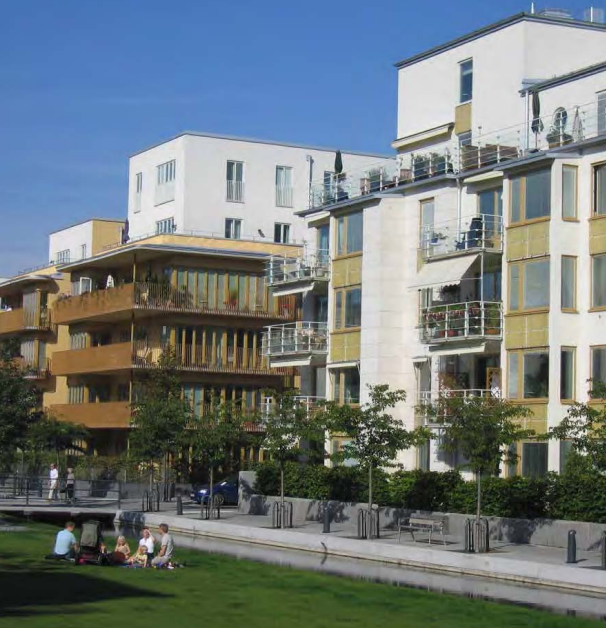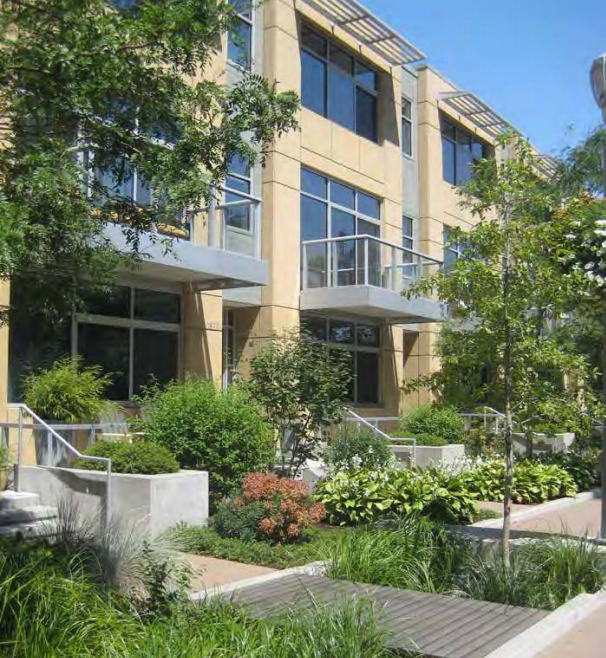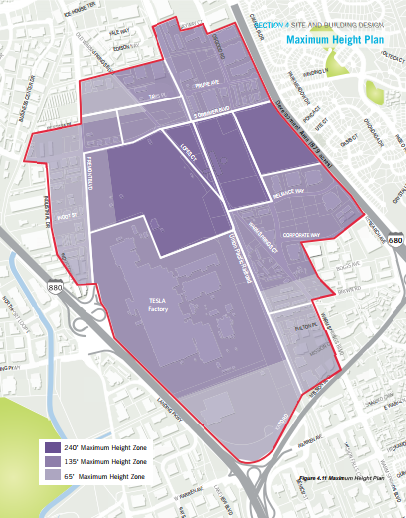
Fremont Master Plans 4/4
Warm Springs/South Fremont Community Plan
Today, the Warm Springs area is in a distinct transition. The area can be partially characterized by large vacant parcels and
underutilized industrial land, but the area is also home to numerous advanced manufacturing and R&D companies. The strong
economic upturn in the Bay area plus the opening of the BART station will provide the Community Plan with the start it so
deserves.
In five years, the urban residential communities, the elementary school and the urban park will all be completed and occupied,
forming the base of the urban vision for Warm Springs. The iconic bridge is expected to be in place, connecting the east
and west of the Community Plan for pedestrians and bicyclists, and much of the planned public infrastructure will be in
place, including the new Innovation Way. And the BART line is schedule to be fully extended and operational to Milpitas and
Berryessa.
Ten years out should show Warm Springs in a whole new light – with supportive retail and hotel uses in place and the
re-establishment of the older industrial areas with renovated, expanded or new buildings. New infrastructure would includ e
completed sidewalks, bike lanes, street trees, intersection improvements, and the addition of signalization where needed.
Finally, in 2035, Warm Springs should be fully urbanized with new office buildings and users, new advanced manufacturing
buildings and R&D businesses, and a substantial portion of the older industrial areas rejuvenated.
To set the transformation in motion, the Vision is of an Innovation District celebrated for its inventive gathering of thought leaders
and their growing businesses, and for its dense mixed-use development with outstanding educational, civic, and residential uses
surrounding the new Warm Springs/South Fremont BART station. As such, the Warm Springs Innovation District offers a unique
opportunity for flexible development at sustainable densities.
This chapter of the Community Plan takes that vision, describes its history and defines its potential. The roots of the vision come
from the leadership of the City Council in its high expectations for this area to deliver a vital, new sustainable district of the City
offering strategically urban living and working opportunities.
This Community Plan will serve as both a planning and an implementation tool for the realization of a living/working district of
innovation. It builds upon specific studies of existing conditions, land use potentials, public and private development strategies,
and transportation and infrastructure investments.
PLAN FOUNDATION
In 2010, the City of Fremont initiated a planning process for the 879 acres in South Fremont, surrounding the Warm Springs/South Fremont BART station, which laid the groundwork for positive change through development of land use alternatives, economic development strategies and transportation/infrastructure assessments.
With the closing of the 5.4 million square foot New United Motor Manufacturing, Inc. (NUMMI) plant, the City of Fremont applied for and received a grant from the U.S. Department of Commerce Economic Development Administration (EDA) to develop a Recovery Strategy for the site and the area surrounding the future Warm Springs/South Fremont BART Station. Tesla Motor’s subsequent purchase of the plant helped to solidify this facility as a major employment anchor for Warm Springs/South Fremont. A Land Use Alternatives Study, and other economic studies were completed to inform the Warm Springs/South Fremont Community Plan.
Supported by a working panel from the Urban Land Institute, the City envisioned a bold strategy to transform this area into an Innovation District and employment center accommodating a mix of compatible uses focused around the synergies embodied in the new BART station and adjacent undeveloped land.
In 2011 and 2012, the City gave substantive attention to the elements of an Innovation District for the Warm Springs/South Fremont area and engaged policy and design to bring these ideas to life. With this work and the encouragement of City leaders, the area was then ready for Priority Development Area (PDA) analysis and the development of a Community Plan. A Priority Development Area (PDA) is a program of the group Focus. Focus is a consortium of regional agencies in the Bay Area that have consolidated their efforts towards encouraging responsible growth, promoting better connections between land uses and transportation and protecting the environment.
The PDA planning program is an initiative to finance planning in PDAs that will result in intensified land uses around public transit hubs and bus and rail corridors. The program is geared toward:
• Increasing jobs and housing supply, including affordable housing.
• Increasing land-use intensities, thereby boosting transit ridership.
• Increasing walking, bicycling, carpooling and car sharing by promoting multi-modal connections.
• Locating key services and retail in the planning area to reduce auto trips.
Planning Elements
Community plans funded through the PDA program are required to address the Station Area Planning Principles outlined in MTC’s Station Area Planning manual. At a minimum, plans are required to includ e the following planning elements:
1. An overview profile of the planning area including demographic and socioeconomic characteristics.
2. A public outreach and community involvement process.
3. Development of several land-use alternatives.
4. A market demand analysis for housing at all levels of affordability, jobs and retail in the planning area.
5. A housing strategy that promotes affordable housing and minimizes the displacement of residents.
6. A multi-modal access and connectivity strategy.
7. Pedestrian friendly design standards for buildings, streets and open space.
8. An accessibility analysis for people with disabilities.
9. A parking analysis to create a policy to reduce parking demand and supply.
10. An infrastructure development analysis and budget.
11. An Implementation plan and financing strategy to ensure the plan will be adopted and policies and programs updated as necessary.
PLAN CONTEXT
Within the Bay Region, the City of Fremont and the Warm Spring/South Fremont district hold the keys to a new economic generator – with the extraordinary resources for success already in place. Among others, and as illustrated by the maps includ ed here (Fig. 1.2 and 1.3), these resources includ e: a central, highly visible location well served by highway, rail and soon to includ e a BART station; underutilized vacant land; interested owners; and a City committed to policies that can change the status quo of suburban development to encourage and enable innovative companies and developers.
Within the City of Fremont, Warm Springs/South Fremont is an area of promise, fueled by international interest in Tesla and the energetic and substantive efforts of the City to re-frame the vision of this place. Surrounding City districts are very different in character. Some provide the essential low density and light industrial settings that support the businesses of the region. South Fremont has an independent, neighborhood character but often feels isolated from the rest of the City. Neighborhoods to the east, divided by the highway, hold a very distinct and separate identity which will soon link more and more strongly with Warm Springs with the BART station area. To the north, there are roadway, bus links and future transit connections to Fremont’s city center.
With the adoption of the General Plan (December 2011) and the Downtown Community Plan (August 2012) and pending City Center Plan, completion of the Warm Springs/South Fremont Community Plan will further the City’s vision for the creation of a sustainable, strategically urban modern city.
The extension of the BART line further south will close the loop for a completely connected Bay area. This further enhances the potential of Warm Springs/South Fremont by providing efficient access to and from San Jose, Santa Clara, San Francisco, and points beyond. Connecting trains at key transit hubs provide rail service to Sacramento, Los Angeles, and all major U.S. cities.



